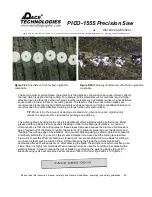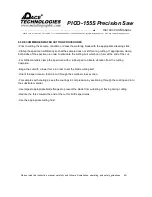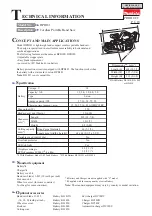
Please read this instruction manual carefully and follow all installation, operating and safety guidelines.
47
PICO-155S Precision Saw
I
NSTRUCTION
M
ANUAL
- - - - - - - - - - - - - - - - - - - - - - - - - - - - - - - - - - - - - - - - - - - - - - - - - - ▲
3601 E. 34th St. Tucson, AZ 85713 USA Tel. +1 520-882-6598 Fax +1 520-882-6599 email: pace@metallographic.com Web: http://www.metallographic.com
TABLE IV. Guidelines for Wafering Cutting Various Materials
Characteristic
Speed (rpm)
Load (grams)
Blade (grit/conc.)
Silicon substrate
Soft / brittle
<300
<100
Fine / low
Gallium arsenide
Soft / brittle
<200
<100
Fine / low
Boron composites
Very brittle
500
250
Fine / low
Ceramic fiber com-
posites
Very brittle
1000
500
Fine / low
Glasses
Brittle
1000
500
Fine / low
Minerals
Friable / brittle
1500
>500
Medium / low
Alumina ceramic
Hard / tough
1500
>500
Medium / low
Zirconia (PSZ)
Hard / tough
1500
>800
Medium / low
Silicon nitride
Hard / tough
1500
>800
Medium / low
Metal matrix
composites
1500
>500
Medium / high
General purpose
Variable
Variable
Medium / high
9.2 CUTTING PARAMETERS
Most wafer cutting is done at speed between 50 rpm and 5000 rpm with loads varying from 10-1000
grams. Generally, harder specimens are cut at higher loads and speeds (e.g. ceramics and minerals)
and more brittle specimens are cut at lower loads and speeds (e.g. electronic silicon substrates) (see
Table IV). It is interesting to note that the cutting efficiency for sectioning hard/tough ceramics
improves at higher speeds and higher loads. Figure 9.8 compares the resulting surface finish for
sectioning partially stabilized zirconia at a low speed/low load (Figure 9-8a) vs cutting at a higher
load/higher speed (Figure 9-8b). As can be seen, partially stabilized zirconia has less fracturing and
grain pull out after sectioning at higher speeds and loads. This observation may seem counter
intuitive, however for sectioning hard/tough ceramics, high cutting speeds and loads result in
producing a crack that propagates in the direction of the cut instead of laterally into the specimen.




































